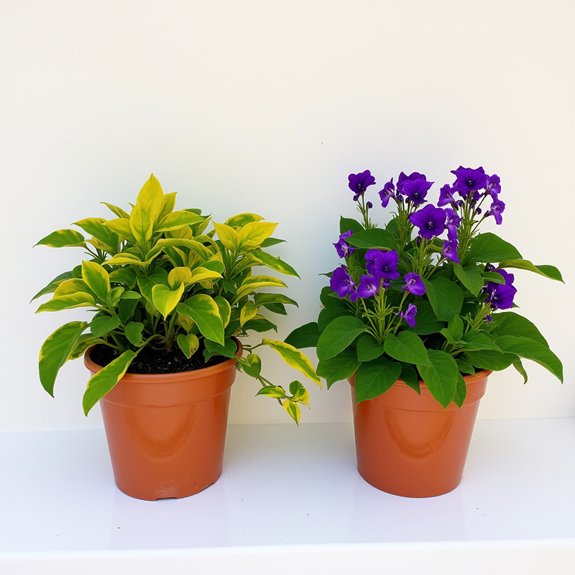African violet enthusiasts often wonder why their plants produce fewer blooms over time, despite consistent watering and proper lighting. The answer lies in strategic pruning, a skill that transforms struggling houseplants into continuous flowering specimens. Most growers unknowingly sabotage their violets by allowing spent flowers and yellowing leaves to drain precious energy from new growth. However, those who master precise trimming techniques discover their plants can bloom year-round with remarkably vibrant colors.
Contents
- 1 Why Pruning African Violets Is Essential for Plant Health
- 2 Optimal Timing and Frequency for Trimming Your Plants
- 3 Essential Tools and Equipment for Effective Pruning
- 4 Step-by-Step Guide to Removing Lower Leaves
- 5 Proper Techniques for Deadheading Spent Flowers
- 6 Identifying and Eliminating Disease and Damage
- 7 Post-Pruning Care and Propagation Opportunities
Why Pruning African Violets Is Essential for Plant Health

While many houseplant enthusiasts view pruning as an optional maintenance task, African violets actually require regular trimming to maintain their health and vibrant appearance. Regular pruning delivers significant pruning benefits by redirecting the plant’s energy toward flower production rather than maintaining old foliage. This targeted approach promotes plant rejuvenation, encouraging fresh growth cycles that keep violets blooming consistently.
Beyond aesthetics, pruning prevents disease spread by eliminating damaged leaves before problems escalate. Improved airflow around the plant reduces fungal issues, while removing spent flowers encourages continuous blooming throughout the growing season.
Optimal Timing and Frequency for Trimming Your Plants
When should gardeners tackle African violet pruning to maximize their plants’ health and flowering potential? The answer lies in establishing a consistent pruning schedule rather than waiting for specific seasons. African violets benefit from gentle trimming every two to four weeks throughout the year, making seasonal considerations less critical than regular maintenance.
During routine watering sessions, gardeners should inspect plants for spent flowers, damaged leaves, and overcrowded foliage. This ongoing approach prevents stress from excessive removal at once while maintaining ideal plant health and encouraging continuous blooming cycles.
Essential Tools and Equipment for Effective Pruning

Simplicity defines the beauty of African violet pruning, as gardeners need surprisingly few tools to achieve professional results. Clean fingers work perfectly for most pruning techniques, allowing gentle pinching of spent flowers and damaged leaves. Sharp scissors or pruning shears provide cleaner cuts when tackling thicker stems or precise trimming work.
The key lies in tool sharpness and cleanliness. Dull cutting tools can crush delicate plant tissue, inviting disease problems. Clean hands prevent transferring harmful bacteria between plants.
Most experienced growers prefer fingers for routine maintenance, reserving scissors for detailed shaping work that demands surgical precision.
Step-by-Step Guide to Removing Lower Leaves
With proper tools in hand, gardeners can begin the most important pruning task: removing the oldest lower leaves from their African violets. Start by identifying the bottom row of leaves, which typically appears yellowed or worn. Gently grasp each leaf stem close to the crown, then twist and pull downward in one smooth motion. This leaf removal technique prevents crown damage while ensuring clean separation.
Focus on removing leaves that touch the soil surface, as these block airflow improvement around the plant’s base. Maintain 10-12 healthy leaves total, keeping the plant balanced and promoting ideal flowering throughout the growing season.
Proper Techniques for Deadheading Spent Flowers

Deadheading spent blooms represents the second critical pruning task that keeps African violets flowering continuously throughout their growing cycle. Proper deadheading techniques involve gently pinching off faded flowers using clean fingers, avoiding damage to the crown or surrounding leaves. This flower care practice redirects the plant’s energy toward producing new blooms rather than seed development.
Remove spent flowers promptly when they begin wilting or changing color. Pinch the entire flower stem close to its base, ensuring complete removal. Regular deadheading every few days during blooming season maintains plant health and encourages abundant flowering throughout the growing period.
Identifying and Eliminating Disease and Damage
Beyond maintaining healthy blooms, gardeners must recognize signs of disease and damage that threaten their African violet’s overall health. Disease identification starts with examining leaves for brown spots, yellowing edges, or fuzzy growth patterns. These symptoms indicate fungal infections or bacterial problems requiring immediate attention.
Damage assessment involves checking for torn, wilted, or blackened foliage caused by overwatering, physical harm, or pest activity. Remove compromised leaves immediately using clean shears, cutting close to the base without damaging the crown. Proper disposal prevents spreading issues to nearby plants, while sanitizing tools between cuts maintains healthy growing conditions.
Post-Pruning Care and Propagation Opportunities
Capitalize on freshly pruned African violets by transforming healthy removed leaves into new plants through propagation. Select sturdy leaves with clean cuts, then place them in light potting mix. Use a toothpick to keep the leaf elevated off moist soil, preventing rot while encouraging root development.
Post pruning watering requires gentle attention, as freshly trimmed plants need consistent moisture without oversaturation. After leaf propagation begins, maintain humidity around new plantings using plastic covers or humidity domes. Within 4-6 weeks, tiny plantlets will emerge from leaf bases, ready for individual pots once they reach one inch tall.
